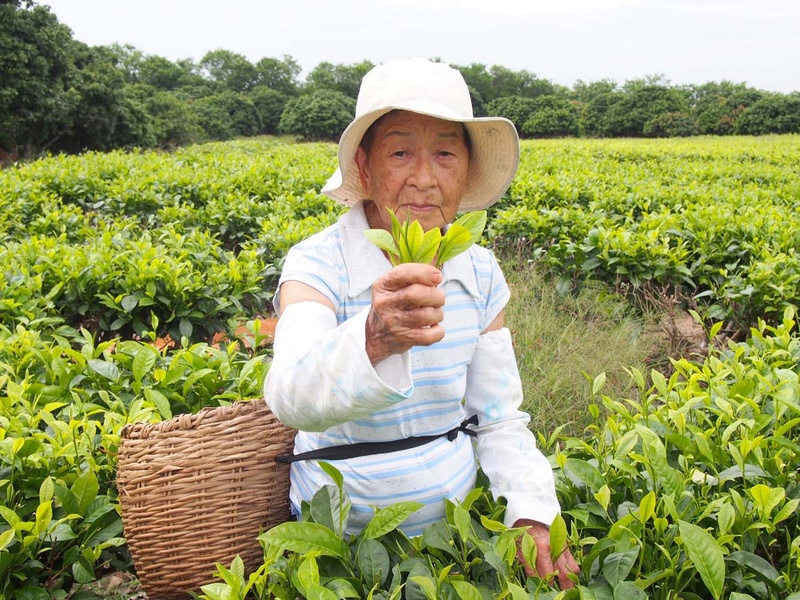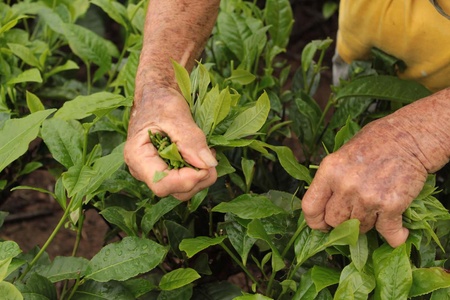Registro, a city in the interior of São Paulo that plays an important role in the culture and history of Japanese immigrants in Brazil, was once known as the capital of black tea in the 1960s. Now, the city sees the old tradition resurfacing.
Obaatian, the resurgence of tea
Swan Yuki Hamasaki, 30, says that the story she hears from her grandmother, Elizabeth Umeko Shimada, 89, is that when she was five years old, her father – Kikuno Sugano – asked her to take care of the black tea seedlings that he had taken home. Mrs. Umeko says she watered it, helped transfer it to pots and also helped plant the seedlings. Thus, they supplied tea leaves to the factories.
More than 40 tea factories opened in Registro. However, due to several factors, mainly economic, they closed one by one. It was then that Mrs. Umeko decided that she should revive the tea culture, and she had already had the challenging experience of planting more than 50 years ago. He also grew pineapple, cassava, avocado, lemon, as well as producing miso , konyaku and tofu .
When she had the idea of setting up the factory, in the first half of 2014, Yuki remembers that her father, Kazuo Hamasaki, and her uncle, Roberto Minoru, went with her to visit old producers, factories and old irons where there were machines available for them to buy. and reform.
The Obaatian (Grandma's Tea) brand was created at the end of November 2014. “Inspired by my grandmother who opened her tea factory, I designed the logo and we started producing the packaging”, he says. The first packaging was ready at the beginning of 2015, at the end of January to the beginning of February, already looking like a product. The current packaging, with barcode and visual identity, only came out in June last year.
What helped make the production possible was the family. When Ms. Umeko is in need, everyone helps as much as they can. She has six children (Shigueru, Bernadete, Roberto, Emi, Wilson and Teresinha), 14 grandchildren and three great-grandchildren. “Like every family, we have our differences, but my grandmother keeps everyone straight when it comes to work,” says Yuki.
His uncle, Minoru, who lives in the interior of São Paulo, together with his mother Aiko and his father, who live in the capital, are “steadfast”. Because whenever necessary, they go to Registro to help her with the farm, “make her dreams come true”.
When production began, the aunt, Teresinha Eiko Shimada Ferreira, 62 years old (who lives on the farm with her husband and owner Umeko), took over processing the leaves. The family is involved, but in reality there is no formal division of functions. “Everyone helps as much as they can, with the time they have, with the availability they have”, comments the grandson.
Yuki says that her grandmother injured her knee and, as a result, she avoids going to the fields to pick tea leaves. However, whenever she can, she goes. “The plantation is still hers, and she’s in charge!”
The production and distribution process for sale
The production process starts from planting, which is the most important. Tea is a delicate drink, and the care taken with the plant is clearly reflected in the flavor. Harvesting must be done by hand to ensure the selection of the best shoots. After harvesting, the “withering” process begins, which is the process of leaf dehydration. It rests for more or less a day, depending on the humidity of each day.
Next comes the maceration process. In general, it is made using a machine, but they are also made by hand in special cases (normally for personal consumption). Then, it enters the oxidation process, which lasts approximately five hours. It is a delicate moment, because if the leaf remains still, it ferments. Therefore, control is constant, stirring the leaves, not letting the temperature rise too high. Lastly comes roasting and packaging. Once packaged, the tea takes six months to become good for consumption and is valid for three years.
The tea needs to rest during the winter and, because of this, it is only produced from September to May – with a production that should reach 250 kg per harvest, around 3 thousand packages. In the months when there is no tea harvest, the farm staff rest and take care of other things.
Chá da Vovó is sold in tea houses and restaurants in São Paulo. Distribution is basically done by the family. In São Paulo, Yuki says that he and his father deliver wherever needed. When the order is placed online or is international, he and his parents are in charge of sending it by post.
Much of the sales happen at fairs and events in which they participate, including organic fairs and Japanese festivals, such as the Japan Festival. At this point, all the cousins are willing to help.
“The family’s goal is to make my grandmother happy,” says the grandson. For Swan, they achieve this goal with each event or good news that the tea brings to Ms. Umeko. “We see the work strengthening the bond and perhaps new dreams will begin to emerge from this work.”

Achievements and the future
In these two years of existence, the Obaatian brand sold around 450 kg of tea. “We want to produce more and better, but the challenges seem greater than they really are when the company is small, and especially when the company is family-owned”, he reveals. Despite the difficulties, acceptance has been great.
Yuki says that her grandmother has plans for the company and they are structuring the business taking into account the longevity of Chá da Vovó, and they are even inspired to face the challenges. There are basically three questions that Ms. Umeko thinks about for the future:
1. Desire for the business to be long-lasting – she wants it to be done well and for her family, children and grandchildren to continue her work.
2. I want young people to be interested in agriculture and for small farmers to have more opportunities.
3. I wish to see tea in full swing in Registro and for the region to develop. Furthermore, she wants the brand to inspire other producers and even wants to help make this happen.
“Obaatian Tea is a success! Success due to the determination not to let the tea culture in Registro (tea capital) end, success due to friendliness and my desire to continue dedicating myself more and more. I am surprised by the success that Ms. Ume achieves with all our strength of wanting to respond, of wanting to continue Obaatian Tea”, says Teresinha.
Without a doubt, black tea is a very important legacy in the history of Japanese immigration in Brazil and in Registro. Yuki says that “it’s a privilege” to be part of the history of the city and of Japanese descendants in Brazil. “Seeing up close the work of my grandmother [daughter of Japanese immigrants from Fukushima province] , my uncles and my parents is a school. I'm learning a lot just being around other generations. It gives me a better perspective on our generation.”
May not only the tea tradition, but Japanese culture as a whole, continue to be passed on to the next generations!
* With information extracted from the Bunkyo Empresarial Bulletin - #5 - October/2016.
© 2016 Tatiana Maebuchi







